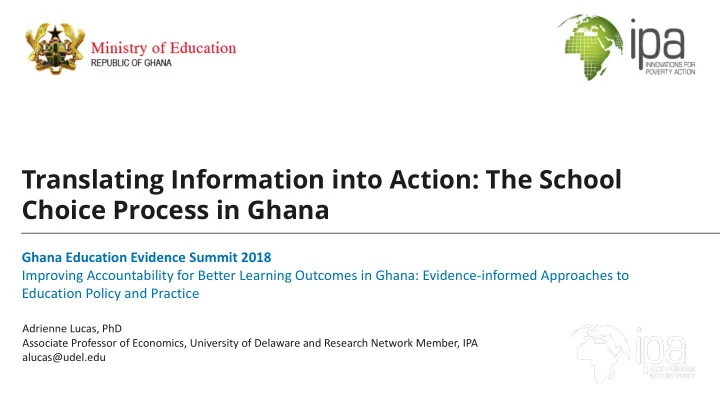

Translating Information into Action: The School Choice Process in Ghana Ghana Education Evidence Summit 2018 Subtitle placeholder Improving Accountability for Better Learning Outcomes in Ghana: Evidence-informed Approaches to Education Policy and Practice Presenter Name A Adrienne Lucas, PhD email@poverty-action.org Associate Professor of Economics, University of Delaware and Research Network Member, IPA alucas@udel.edu
Key findings We provided information to students and parents on the school choice process Students and parents received our information • Students changed some of the attributes of the secondary schools to which • they applied—they internalized the information Our information did not improve education outcomes—students no more • likely to start school on time or matriculate at all Open questions: The information students and parents said they wanted changed their • choices but did not improve outcomes—Is it about match quality? What are the constraints?
Guidance and Information for Improved Decisions in Education in Ghana – GUIIDE Outline Background and Motivation • Designing GUIIDE • Evaluating GUIIDE • Preliminary Results •
Context: Secondary School Choice Process in Ghana A basic overview Each student 1. Submits ranked list of up to four secondary schools 2. Takes the Basic Education Certification Exam (BECE) 3. Is admitted to at most one school based on BECE score and ranked list by Computerised School Selection and Placement System (CSSPS) Similar systems elsewhere in Africa and beyond
Policy Issue While simple to describe, picking schools can be complex due to lack of • information—where are the schools? How difficult are admissions? What are WASSCE outcomes? Creates inefficiencies for the school sector and households • Students use dominated strategies • Students matriculate late or not at all • Students attend schools where very few pass the secondary school • certification exam (WASSCE) Does improved information reduce these inefficiencies?
What do students want to know? Most important school characteristics when applying to secondary school Academic performance Distance Cost Admission chances Future success Teacher quality Boys or girls only Other 0 10 20 30 40 Percentage of students
GuIIDE: Guidance and Information for Improved Decisions in Education School-based information workshops School Meeting Booklet Video Ask enumerator questions • • Application strategies • Dramatization of process School information •
Evaluation 900 Junior High Schools in Ashanti region Randomly assigned to one of three groups: Information to students Comparison group: no Information to students and parents information
Data Collection Baseline: January 2016—student and guardian surveys (JHS 3) • Follow-up 1: March 2016—student and guardian surveys (after CSSPS • forms due, JHS 3) Administrative Data—BECE scores, CSSPS placement • Follow-up 2: March 2017—student or guardian surveys (SHS 1) • Follow-up 3: ongoing—student or guardian surveys •
Preliminary Results
Information Reached Participants Students saw the booklet and • 97% 96% 100% 93% 91% video 90% 82% Students used the booklet 80% • 70% Percent of Students 60% 50% 39% 38% 40% 30% 21% 20% 14% 10% 0% Seen booklet Seen video Use Booklet for Info Information to students and guardians Information to students Comparison group mean
Information Changed Priorities Students more likely to say • 10% 9% the key was distance or admit 9% chance—both featured in 8% 7% booklet 7% Percent of Students 6% 6% 5% 5% 4% 3% 3% 3% 2% 1% 0% Key = Distance Key = Admit Chance Information to students and guardians Information to students Comparison group mean
Information Changed Applications Students in treatment schools more likely to • select all schools in Ashanti (5 percentage points, 78% base) • select schools with lower historical BECE scores (5% SD, 3-4 points in choices 2 • through 4) , but schools not lower quality as measure by WASSCE pass rates
Information Did Not Change Admissions or Matriculation No more likely to be admitted • 100% to a “selected” school 86% 90% 82% 82% 80% No more likely to be attending • 70% CSSPS school Percent of Students 60% 60% 58% 60% 53% No more likely to be attending • 51% 49% 50% any school 40% 30% 20% 10% 0% Admitted by CSSPS to Choice Attending CSSPS School Attending Any School 1-4 Information to students and guardians Information to students Comparison group mean
Conclusions and Policy Lessons • Students received information that they claimed they valued • Students changed their application behavior in response to the information • Ultimately, did not improve efficiency in secondary school allocation— students no more likely to be attending their CSSPS school or any school • In process of additional survey round to understand why… • Was the intervention too late? • Did they not learn enough?
Acknowledgements This project would not have been possible without Exceptional Co-authors: Kehinde Ajayi (World Bank) and Willa Friedman • (University of Houston) Generous Funders: J-PAL Post Primary Education Initiative, Weiss Family • Program Fund Tremendous IPA Ghana team: Madeleen Husselman, Christine Papai, Kym • Cole, Bridget Gyamfi, Gloria Abankwa, Jonathan Addie, Cornelius Adjei, Isaac Djabatey, Helen Habib, and many, many enumerators
Thank you
Recommend
More recommend